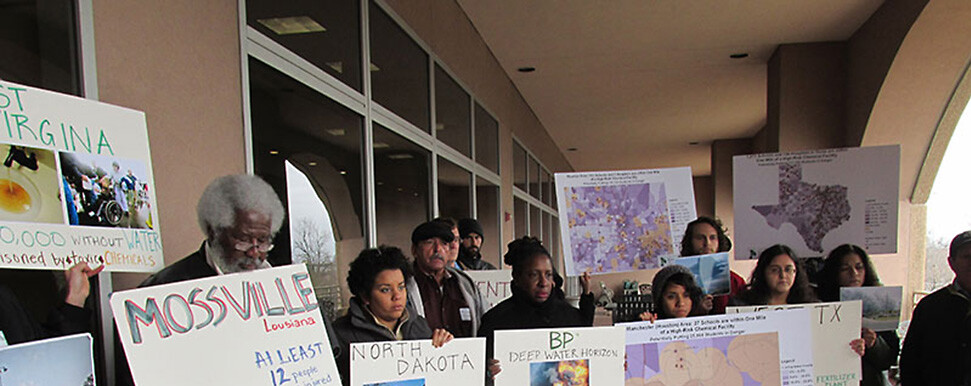
Media
December 14, 2017Press Release: Communities to be Harmed by EPA Budget Cuts Ask Congress for Protection
Trump Administration’s Budget Proposal Currently Being Considered by Congress Endangers Fenceline and Environmental Justice Communities
View the Community Letters Here: http://ej4all.org/campaigns-and-activities/epa-budget-letters
Washington, D.C.— As Congress continues its consideration of the Trump Administration’s proposal to slash funding for the U.S. Environmental Protection Agency (EPA), a coalition of community environmental justice and health groups issued a volley of letters urging appropriators to maintain funding for vital health and safety programs. The letters, sent from communities across the nation who are dealing with disproportionate levels of environmental pollution, detail how EPA programs—especially Environmental Justice program and grants designed to support the most impacted communities—have improved public health and provided economic benefits in their neighborhoods, and how starving these efforts may put people directly in harm’s way.
Senate Appropriations Committee Chairman Thad Cochran recently released his own version of the Fiscal Year 2018 EPA appropriations bill (which has not been scheduled for any debate by the full Appropriations Committee), and although its proposed cuts to EPA programs aren’t as severe as the Trump Administration’s, the threat of massive cuts to public health and justice programs still remains. The Administration’s proposed budget seeks to cut funding to the EPA by 30% and completely eliminate EPA’s Office of Environmental Justice, while both Chairman Cochran’s proposal and the EPA budget passed by the U.S. House of Representatives still reduce funding for the EPA and it’s programs substantially. While both the House bill and Chairman Cochran’s Senate proposal include various policy ‘riders,’ neither directly addresses whether EPA must maintain its Office of Environmental Justice or any programs, staff, or funds targeted to Environmental Justice communities. A final FY 2018 EPA appropriations package is expected from Congress this month.
“The Trump Administration’s proposal to gut the EPA—thereby endangering people whose health and safety depends on federal oversight—is truly reckless and short-sighted,” said Richard Moore, Co-Coordinator of the Environmental Justice Health Alliance. “These community letters from across the nation show that EPA environmental justice programs both prevent health impacts and provide strong economic returns on our investment. The Administration’s disregard for these fiscally sound and clearly beneficial programs—and the health benefits they provide or lives they protect—imply that this administration is more interested in scoring points with industries who benefit from sacrifice zones or polluting the environment rather than true leadership toward solving our environmental problems. Unfortunately, neither the EPA Administrator nor the White House have publicly withdrawn the proposal to eliminate the Office of Environmental Justice, or their budget proposal to gut EPA programs that help protect our communities, and the House and Senate bills are silent on these issues. The Senate should clearly direct EPA to maintain its environmental justice office, programs, and grants in any appropriations bill.”
In addition to proposing severe cuts to EPA’s overall budget and the elimination of the Office of Environmental Justice, the Trump Administration also proposed cutting Brownfield remediation programs by more than 30%.
“In Louisville, KY, EPA programs have helped reduce toxic air pollution and given our economy a much needed boost,” said Eboni Cochran, Co-Director of Rubbertown Emergency Action. “Kentucky has received $12.9 million in EPA Brownfield grants, and EPA estimates that 8.5 jobs are leveraged for every $100,000 of Brownfield funds expended. In short, this means that EPA’s Brownfields program has helped create hundreds of jobs for people in Kentucky. Trump’s proposal to slash funding for EPA’s Brownfields program means more contamination, more cancer, more asthma, and less job creation for Kentucky.”
“For 65 years I’ve lived in an area of Charleston, WV called ‘Chemical Valley’, and I can’t count how many times we’ve been ordered to ‘shelter-in- place’ because a nearby facility released toxic gas,” said Pam Nixon, President of People Concerned About Chemical Safety. “It’s scary to know that chemical facilities in my area could explode at any moment and change our lives forever. Recently, Freedom Industries spilled a coal-processing chemical into our drinking water which then turned the lives of 300,000 people in nine counties upside down. This spill cost our economy roughly $19 million each day. These risks and exposures are a ‘toxic chemical trespass’, which none of us signed up for, but which we are frequently forced to deal with. No one deserves to live under these conditions, but if the EPA’s budget is slashed, there will likely be fewer ‘cops on the beat’ to protect communities like mine. We aren’t a sacrifice zone, and we deserve the same protections that wealthier and more affluent communities in America get.”
The organizations which issued these community letters are urging all members of Congress to reject all of the Trump Administration’s proposed cuts to EPA’s budget and programs, and fully fund the EPA and its programs at fiscal year 2017 levels or above, including all Environmental Justice programs, staff, and grant programs.
The Community Letters Can Be Viewed Here: http://ej4all.org/campaigns-and-activities/letters-opposing-cuts-to-the-epa-budget
Background
Research organized by EJHA describing the challenges environmental justice communities face and the demographics of those living near hazardous chemical facilities can be found in the following reports:
- Environmental Justice for Delaware: Mitigating Toxic Pollution in New Castle County Communities
- Living in the Shadow of Danger: Poverty, Race, and Unequal Chemical Facility Hazards
- Who's In Danger: A Demographic Analysis of Chemical Disaster Vulnerability Zones
The Environmental Justice Health Alliance (EJHA) organizes industry reform strategies for safer chemicals and clean energy that leave no community or worker behind. Learn more at http://ej4all.org/
###
Available for Comment
Eric Whalen; Communications Coordinator, Coming Clean; (971) 998-8786, ericwhalen@comingcleaninc.org.
